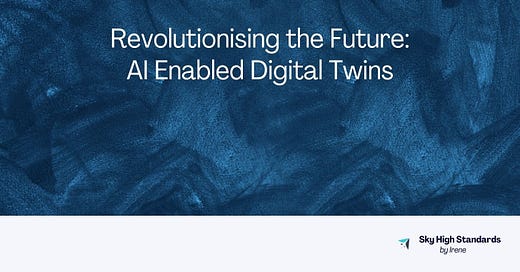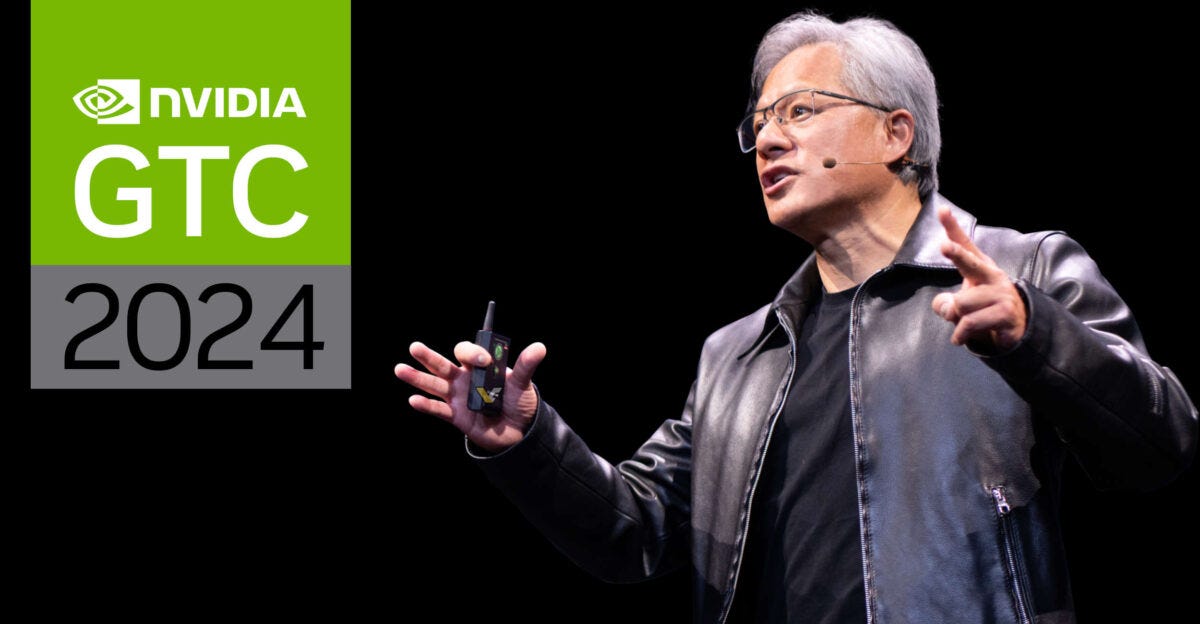Revolutionising the Future: AI Enabled Digital Twins
Nvidia's 2024 GTC keynote unveils groundbreaking AI and digital twins, revolutionising computing, efficiency, and futuristic AI applications
Nvidia's GTC (GPU Technology Conference) keynote on March 18th has truly blown my mind! 🤯
It felt like watching a science fiction film in a cinema, complete with popcorn.
If you're keen to discover the latest developments in the high-tech space and understand the context in which Nvidia's CEO, Jensen Huang, used such impactful phrases as "new industry," "new era of computing," and "new industrial revolution," you cannot miss it. Link here.
Among the announcements were:
The Blackwell GPU platform: dubbed "the most powerful chip," capable of running generative AI LLMs with 25 times less cost and energy than its predecessor, Hopper.
The Omniverse computing platform: enables individuals and teams to develop metaverse (3D evolution of the internet) workflows and industrial scenes. Partnership with Apple Vision Pro.
A 3D blueprint for "next-gen" AI data centres.
Project GR00T: a foundational model for humanoid robots as the "next wave" of AI and robotics.
Today, however, I want to focus on one of the highlights of the event: the integration of AI with Nvidia's Omniverse platform, particularly regarding the enablement of advanced AI-Enabled Digital Twins.
I review:
The definition and characteristics of AI Enabled Digital Twins.
Foundational Elements of AI Enabled Digital Twins
Examples of AI Enabled Digital Twins
Applications of AI Enabled Digital Twins in Aerospace Maintenance
Conclusions
Let’s dive in! 🤿
Definition and characteristics of AI Enabled Digital Twins
The concept of digital twins has been evolving for several decades but began gaining significant traction in the early 21st century. The term "digital twin" itself is attributed to Dr. Michael Grieves at the University of Michigan in 2002, during a presentation on Product Lifecycle Management (PLM).
Initially, he referred to it as a "mirrored spaces model" but later adopted the term "digital twin", which more accurately captured the essence of creating a digital replica of a physical object or system.
By the 2010s, digital twins had become a key technology across industries such as aerospace, automotive, manufacturing, and construction, thanks to their ability to improve efficiency, reduce costs, and enhance the development and maintenance of products and systems.
With the advent of several key technologies, including the 3D internet, a new class of AI Enabled Digital Twins has emerged.
These advanced models enable accurate and reliable virtual testing, experimentation, and optimisation of unique objects, processes, or environments.
They are constantly synchronised with real-world data inputs and powered by AI, offering:
A single source of truth for virtual datasets.
Adherence to the laws of physics.
Precise timing and perfect synchronisation with the real world.
Optimisation through AI and the ability to train AI models.
Foundational Elements of AI Enabled Digital Twins
The foundational elements of AI Enabled Digital Twins represent a convergence of various technologies, each playing a crucial role in creating these advanced virtual models.
These elements not only enable the creation of a digital twin but also enhance its functionality with AI.
Here's a breakdown:
IoT: Collects real-time data, making digital twins dynamic and reflective of their physical counterparts.
Big Data Analytics: Processes and analyses data from IoT, offering insights for future predictions and issue identification.
Cloud Computing: Provides scalable computing and storage resources to manage data and run simulations.
AI and ML: Enable learning from data, future state predictions, process optimization, and automated decision-making.
Simulation and Modelling: Uses advanced software to accurately replicate physical behaviours for realistic simulations.
Cybersecurity: Protects sensitive data from unauthorized access, ensuring data integrity.
Integration Capabilities: Allows seamless data flow by integrating with other systems like ERP and MES.
Interoperability Standards: Ensures communication and operation with other digital systems for collaboration across industries.
These foundational elements collectively enable the creation and operation of AI Enabled Digital Twins, offering sophisticated tools for analysis, prediction, and optimisation that were not possible with earlier generations of digital modelling technologies.
Examples of AI Enabled Digital Twins
Nvidia's CEO envisions a future where digital-first manufacturing becomes the norm:
“Everything in our company has a Digital Twin” as said by NVIDIA CEO Jensen Huang. “It helps companies to build very complicated things perfectly the first time”.
See below a video with an example as showcased during the event. It talks itself.
The results:
Increased worker efficiency by 51%
Factory built in half the time
Reduction end-to-end cycle time by 50%
Reduction of defect rates by 40%
Applications of AI Enabled Digital Twins in Aerospace Maintenance
It’s inevitable, the potential of AI Enabled Digital Twins is huge.
See below three examples applied in Aerospace Maintenance:
Designing Aircraft Hangars or Warehouses: AI Enabled Digital Twins can be used to simulate and optimise the design of new aircraft hangars or warehouses. By creating a virtual replica, designers can test different configurations to maximize space utilization, efficiency, and safety without the need for physical models.
Optimising Operational Workflows: Before implementing changes in operational workflows, AI Enabled Digital twins allow aerospace companies to simulate those changes in a virtual environment. This can include optimising maintenance procedures, redesigning the layout for better efficiency, or integrating new technologies into existing systems. Digital twins enable the analysis of impact without disrupting ongoing operations, providing valuable insights into potential improvements or identifying unforeseen challenges.
Enhancing Supply Chain and Logistics: AI Enabled Digital Twins can revolutionise how aerospace companies manage their supply chains and logistics. By creating digital replicas of the entire supply chain, from parts procurement to delivery, companies can simulate various scenarios to identify bottlenecks, predict delays, and optimise routes, leading to a more resilient and efficient supply chain.
Simulating emergencies or complex repairs: By creating high-fidelity digital replicas of aircraft, components, or entire systems, these virtual models can simulate a wide range of emergency scenarios and repair processes in a safe and controlled environment. This capability allows engineers and technicians to get trained and to explore various outcomes, test different solutions, and refine procedures without the risks and costs associated with real-world trials.
Conclusions
The potential of AI Enabled Digital Twins is vast, extending across industries and transforming how companies approach design, development, and maintenance.
In a few words as Nvidia’s CEO says:
“That’s the way it’s going to be in the future when we’re manufacturing digitally first and then we’ll manufacture it physically”.
My perspective aligns with this vision: the adoption and sophisticated application of AI Enabled Digital Twin technology will be a key differentiator among competitive companies in the future.
The use of such an advance technology will set a new benchmark for success in the “digital age”.
References
Nvidia - Digital Twins Overview; accessed March 2024.
YouTube - GTC March 2024 Keynote with NVIDIA CEO Jensen Huang
This is all for today.
See you next week 👋
Disclaimer: The information provided in this newsletter and related resources is intended for informational and educational purposes only. It reflects both researched facts and my personal views. It does not constitute professional advice. Any actions taken based on the content of this newsletter are at the reader's discretion.





